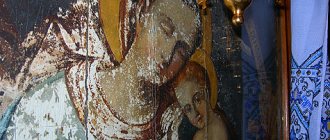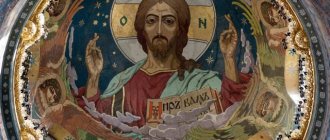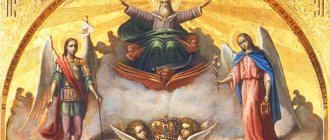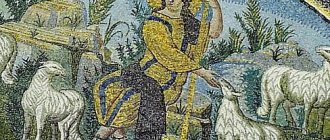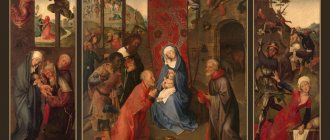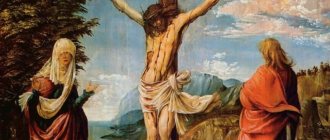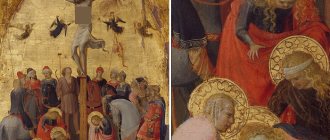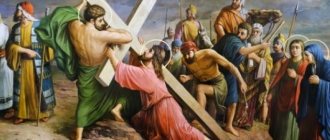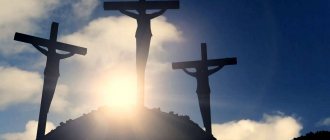Jesus Christ had yellow eyes
The crazy idea to restore the original appearance of Christ did not come to the professor by chance. Representatives of law enforcement agencies often turned to him, one of the leading experts on ancient icons, for help in dating ancient icons, expert assessment and determination of authorship. I had to communicate with thieves and underground collectors. So Sapunov began to understand the theory of investigative inquiry quite well. “I began to study the Gospel,” says the scientist, “using Russian, American and German investigative techniques. The test system unequivocally confirmed: there are no contradictions in the “testimonies” of the four evangelists - Mark, Matthew, Luke and John - who talk about Christ! Then I took texts, recognized by modern theological and classical science as apocrypha or forgeries, which contained a description of the appearance of Jesus. And he wrote out the “witness testimony” according to the investigative template: height, hair, eyes, nose, mouth, etc. It turned out that these texts, considered unreliable, do not contradict each other in one thing: they describe the same person! As a result, I was able to establish that Jesus Christ is a man eighty-five meters tall, thin, with brown curly hair, a narrow face with a straight thin long nose and yellow irises. By the way, according to research by physiognomists, this eye color is characteristic of very strong-willed people. By the way, Stalin had the same eyes. Christ had thin long fingers, a slightly stooped figure and, apparently, one shoulder slightly higher than the other. A prominent specialist in the field of forensic medicine, professor at St. Petersburg University V.P. Petrov told me that this description resembles the symptoms of Morphan syndrome. These people constantly experience a powerful release of catecholamine hormones into the blood, which include adrenaline. In ordinary people, such a high level of hormones is observed only under stress, but in “morphans” - always. They are incredible workaholics. Among these “sick people” are Lincoln, Andersen, Chukovsky, de Gaulle. If Christ was an ordinary earthly man, such a diagnosis partly explains his brilliant mind and excellent oratorical abilities. In the FSB laboratory, where portraits of criminals are recreated from descriptions, the first ever identikit of Jesus was made. “I was surprised by the conclusions of the anthropologists to whom I showed the composite photo,” says Sapunov. “It turns out that the person depicted in the portrait does not belong to the Semitic type, but to the Greco-Syrian type!” This means that by blood Jesus did not belong to the Jews. I'm sure that's why he was executed. Jesus, not being a Jew, dared to reform the teachings of Moses, denying the most important commandment of the Old Testament prophet about the exclusivity of the Jewish people. ...Sapunov compared his sketch with the image on the Shroud of Turin (it is believed that Jesus was wrapped in it after the crucifixion and his body was imprinted on it). The reconstruction of the face on the canvas, made by American scientists, is 90 percent identical to the identikit made by employees of the St. Petersburg FSB. “Of course, there are some differences,” Sapunov admits. “But the shroud bears the image of a dead man, whose facial features were distorted by torment and death.” And in the identikit he is alive and well.” Igor CHERKASOV. Saint Petersburg. BY THE WAY, British scientists have recreated the appearance of a man who lived in Jerusalem in the 1st century AD. e. They did this using computer reconstruction from a well-preserved skull. The British believe that Christ could have looked similar: a wide peasant face with a large nose, dark olive-colored skin (judging by the climate) and short curly hair (as in the frescoes of the 1st - 3rd centuries). In general, it does not look at all like the usual images of Jesus. How Christ is described in religious texts Epistle of Lentulus (proconsul of Palestine) to the Roman Senate: “A tall man. His hair is dark brown, almost smooth up to the ears, and curly below, the lines of his nose and mouth are impeccable, his beard is thick... He carries himself proudly and straight, his arms and shoulders are full of grace.” Theologian John of Damascus: “... had... a black beard, a straight nose, somewhat bent at the shoulders.” CONTINUING THE TOPIC The Shroud of Turin is real! “Can the secret of the Shroud of Turin be revealed in the Kremlin?”, March 7 We told you that our scientists offer their hypotheses about the appearance of the image of Christ on the fabric and determining the age of the shroud (remember: radiocarbon dating showed that the fabric was made in the 13th - 14th centuries. And since then For now, scientists are wondering what is kept in Turin - the funeral painting of Christ or a medieval fake). We also wrote that in the Kremlin Armory, perhaps, there is a cross where a piece of that very shroud is walled up! Shroud researchers recently gathered at a congress in Vienna to share the results of their latest research. The unanimous conclusion: most likely, the canvas stored in Turin is the same one in which Christ was wrapped after death. The arguments are as follows: professor from Italy Piero Savarino compared the results of chemical and spectral analyzes of the shroud and is confident that the image of a person on the shroud appeared as a result of oxidation of the fabric and dehydration of individual threads at low temperatures. It was impossible to specifically recreate such a complex process in the Middle Ages; Swiss textile expert Fluri Lemberg believes that the fabric of the shroud, in terms of weaving threads and other details, is the same as what was made on the shores of the Dead Sea during the life of Jesus. “The linen has been woven since 40 BC. e. until 70 AD e. The fabrics of the 13th - 14th centuries look different,” said the Swiss woman. Dr. Bollone from the University of Turin noticed traces of two coins from the times of Pontius Pilate on the shroud. AND AT THIS TIME, another shroud was found in Jerusalem. British archaeologists announced that they had found another shroud near Jerusalem. A man buried in the valley of Ginnom was wrapped in it. Namely, it was there that the palace of the Roman procurator of Judea Pontius Pilate stood, at whose command Christ was crucified. — In those days, Jerusalem was a small village. Perhaps this man saw the crucifixion on Golgotha, suggests Shimon Gibson, an archaeologist who discovered the burial with the shroud. The new shroud was subjected to carbon dating. He showed: the fabric was made about 2000 years ago! Now researchers hope to compare the find with the Turin relic. Yulia SMIRNOVA. RESPONSES Is the mark of a dying body a physical phenomenon? “You wrote that the image on the Shroud of Turin looks like a negative. I want to tell my story about how a negative image of a dying person appeared. Anna Nikolaevna Toporkova, a librarian, worked in our design organization. She lived alone with her mother. When her mother died, Anna Nikolaevna said that her mother’s body left a strange mark on the floor. During a heart attack, the mother managed to reach the door and fell on the painted floor. When the daughter came home from work and lifted the mother’s body onto the sofa, there was a trace of the body on the floor - like a negative, even the scattered hair left a trace, every hair. The floor was then repainted. Anna Nikolaevna has also been dead for a long time, but her story remains in my memory.” Alevtina Ivanovna Velikoretskaya. Ekaterinburg. PERSONAL PROFILE Boris SAPUNOV, full member of the Peter's Academy of Sciences and Arts, chief researcher of the Hermitage, specialist in ancient icons.
Work experience - 50 years.
But is this what he really looked like?
Most likely no.
In fact, the image that has become familiar appeared in the Byzantine era, starting in the 4th century. In Byzantium, the main emphasis was on the symbolism of the image of Christ, and not on historical accuracy.
Scientists believe that the image of Christ with long hair and a beard is unlikely to correspond to reality. Perhaps Jesus had a beard, as is typical of wandering sages, but only for the reason that he did not visit the barber.
In the ancient world of the 1st century, it was considered obligatory for a man to be clean-shaven and have a short haircut. Long luxurious hair and beard were the destiny of the gods. Even some philosophers cut their hair.
In ancient times, a beard was not considered a distinctive feature of Jews. Moreover, when the Jews were persecuted, it was difficult for the persecutors to distinguish them from everyone else (this is described in the Book of Maccabees). And on the coins issued by Rome after the capture of Jerusalem in 70, you can see captive Jews with beards.
So it is possible that Jesus - according to the tradition of the philosophers - had a short beard, like the men on Roman coins, but more likely he had short hair.
Height, weight and age of Christ
Jupiter is western in the chart, so according to Lilly, “opens up medium height, leaning towards high.”
If the height of ancient Russian warriors was 150 - 165 centimeters, then 2,000 years ago a man with a height of 175 - 180 centimeters was truly a giant...
To describe the form of the body, Lilly considers the rising sign and its ruler, the planet or planets on or aspecting the Ascendant, the two luminaries, namely the Sun and the Moon, the season, and the fixed stars on or near the Ascendant's cusp.
Forensic experts have restored the true appearance of Jesus Christ (4 photos)
Using modern technology and the skulls of ancient Semites, forensic experts have determined that the appearance of Jesus Christ was not the same as it is usually depicted in icons.
A handsome man of Caucasian appearance, with flowing curls of dark brown hair, a thick forked beard the color of wheat, blue or brown eyes - this is how most of us saw Jesus Christ thanks to religious paintings. But a team of forensic scientists managed to obtain a more accurate image of the Christian Messiah. University of Manchester medical artist Richard Neave has recreated the face of God's son by studying Semitic skulls and using modern forensic techniques.
According to an article published by the scientific journal Popular Mechanics, the "medical portrait of Jesus" shows a man with a broad, dark face, large nose, dark eyes, a thick beard and short curly hair. This appearance was most likely more typical of Middle Eastern Jews in the Galilee in northern Israel. The scientist emphasized that he had obtained an accurate portrait of an adult living at the same time and in the same place. Experts say the description of Jesus in some texts may have been more accurate than the paintings of ancient artists who painted faces using sculptures or verbal descriptions. The team of scientists used the description of Christ given by the evangelist Matthew. At the same time, they managed to combine the description of appearance with a new scientific direction - forensic anthropology, used in the fight against crime. Together with Israeli archaeologists, the scientist managed to create a computer model of the appearance of the son of God, proving that Christ had the characteristic features of the Galilean Semites of that time. During the work, experts studied three well-preserved skulls from Jerusalem, where Jesus lived and preached. They then recreated the muscles and skin on the skull in the same way that forensic detectives create an identikit of a living person using just their skeleton. Including the shape of the eyes, lips, nose and major muscles of the skull.
About the mind or understanding of the native
According to William Lilly: “The meaning of mind and intellect is taken chiefly from Mercury and its configuration with the Moon, for it rules the rational soul and the animal spirits of the brain, while the Moon rules the vegetative forces of the brain, which is closer to the sensations...
So if Mercury is stronger than the Moon and in the signs of commanders or long ascension, and the Moon is in obedient signs and of short ascension, in the one born then, reason will prevail over other extravagant feelings.
If the Moon is stronger than Mercury in this sense, as often happens, passions and other internal abilities will easily prevail over reason.”
Reason VS feelings?
Returning to the horoscope of Jesus Christ, we note that both Mercury and the Moon are located in the signs of short ascension - Capricorn and Gemini, respectively.
But the Moon in Gemini - in a submissive sign, in contrast to Mercury in Capricorn - a violent sign as the abode of Saturn and the exaltation of Mars, ensure that "reason will prevail over feelings."
In general, Mercury is discussed in detail both here, when interpreting the 1st house, and in Chapter 1 of Part 3, which examines the cosmogram, therefore there are no “blank spots” in this topic.
Source

